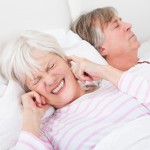
Obstructive sleep apnoea-hypopnoea (OSAH) can be defined as the coexistence of excessive daytime sleepiness with irregular breathing at night. OSAHS is causally linked with hypertension, increased road traffic risk and quality of life problems. Continuous positive airway pressure (CPAP) is the recognised first line of treatment for severe OSAHS but the benefits may be less in milder disease. Intolerance of CPAP is common and can affect between 46-83% of patients.
The aim of this study was to compare the clinical and cost-effectiveness of a range of mandibular advancement devices (MADs) against no treatment in mild to moderate OSAHS.
Methods
Adults age 18 or more with mild to moderate OSAHS confirmed by respiratory polysomnography were randomised to 6 weeks of treatment with three non- adjustable MADs: self-moulded (SleepPro 1; SP1); semi-bespoke (SleepPro 2; SP2); fully-bespoke MAD (bMAD); and 4 weeks no treatment.
The primary outcome was Apnoea-Hypopnoea Index (AHI) assessed by a polysomnographer blinded to treatment. Other outcomes included rPSG indices, blood pressure, subjective sleepiness (ESS), sleep-related quality of life (Functional Outcomes of Sleep Questionnaire (FOSQ); Calgary Sleep Apnoea Quality of Life Index (SAQLI)) and generic HRQoL (Short Form 36 (SF36); EuroQol (EQ-5D-3L)).
Results
- 90 patients were randomised ( 16 withdrew)
- All three MADs significantly decreased the AHI against no treatment All MADs decreased ESS significantly compared with no treatment,
| Appliance type | Apnoea-Hypopnoea Index (AHI): % (95% CI) | Epworth Sleepiness Scale (ESS) score: Units (95% CI) |
| SP1 | 26% (11-38%) | 1.51 (0.73 to 2.29) |
| SP2 | 33%(24-41%) | 2.15 (1.31 to 2.99) |
| bMAD | 36% (24-45%) | 2.37 (1.53 to 3.22) |
- Mean (SD) mandibular protrusion for the SP1 was greater than for the other two devices.
- Patients found the SP1 less comfortable and were less satisfied with it than the SP2 and bMAD
- There were four serious adverse events during the trial.
- Minor adverse events were experienced by 86 (96%) patients. Most common were mouth problems/discomfort (83, 92%) and excess salivation (48, 53%)
- All devices were cost-effective compared with no treatment at a willingness-to-pay (WTP) of £20 000/QALY, based on mean costs and QALYs. SP2 achieved the highest net monetary benefit at £33 per 4 weeks.
Conclusions
The authors concluded
Non-adjustable MADs achieve clinically important improvements in mild to moderate OSAHS and are cost-effective. Of those trialled, the semi-bespoke MAD is an appropriate first choice.
Commentary
This was a well-conducted but complex trial involving a four period cross-over with each patient experience each of the three MADs for 6 weeks and a 4-week period of no treatment. All the MADs achieved a modest reduction in AHI and a statistically significant improvement in ESS. The 3 MADs increased in cost and complexity of construction from a simple ‘ boil in the bad ‘ type (SP1) to a professional fitted and constructed device (bMAD) with the semi-bespoke device (SP2) being most cost effective.
While the trial did show benefit from the MADs this was only a short –term study so further information on log-term compliance and other impacts is needed. Previous reviews (Dental Elf 18th July 2014) have highlighted the limited quality of studies in this area but have suggested a benefit from MADs.
The nature of the 4 serious adverse events were not clarified.
Links
Original Trial Protocol ( Lancet Protocols)
Quinnell TG, Bennett M, Jordan J, Clutterbuck-James AL, Davies MG, Smith IE, Oscroft N, Pittman MA, Cameron M, Chadwick R, Morrell MJ, Glover MJ, Fox-Rushby JA, Sharples LD. A crossover randomised controlled trial of oral mandibular advancement devices for obstructive sleep apnoea-hypopnoea (TOMADO). Thorax. 2014 Oct;69(10):938-45. doi: 10.1136/thoraxjnl-2014-205464. Epub 2014 Jul 17. PubMed PMID: 25035126.

Don’t miss: Mandibular advancement devices for mild obstructive sleep apnoea http://t.co/PVI1rTS7K5
This begs the question “why do so many people have retrognathic mandibles?”. Perhaps orthodontists should be bringing the mandible further forward. Functional orthodontists achieve this by sagittal development of the maxilla. Good looking people, ie actors, have this profile.